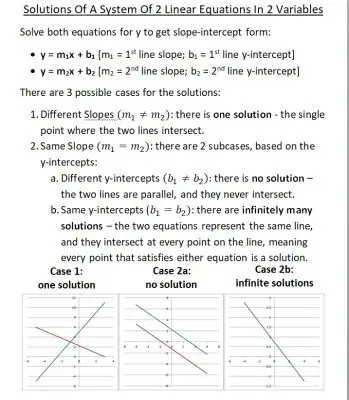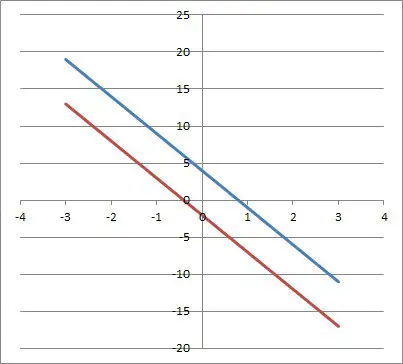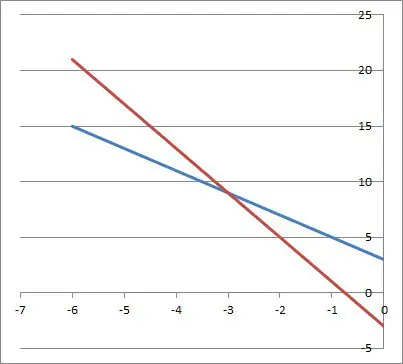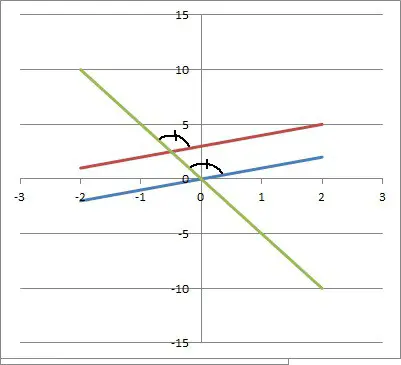Two Lines Are Parallel If
Parallel lines are used often in geometry (for proofs) or in algebra (every bit the result of systems of linear equations). No matter how you lot utilize this important concept, information technology helps to know when two lines are parallel.
So, when are two lines parallel? Parallel lines have the aforementioned slope just dissimilar y-intercepts, which ways that the two lines never intersect. That is, in that location is no indicate that lies on both lines. Parallel lines are always the aforementioned altitude apart. A transversal intersecting the two lines will form congruent respective angles.
Of class, you might not always have a graph of the two lines available. In that case, it might be faster (and more accurate) to examine the equations than to graph both lines.
In this commodity, nosotros'll talk near when ii lines are parallel and how you can tell. We'll also wait at some examples of parallel lines to brand the concepts clear.
Let'southward go started.
When Are Two Lines Parallel?
Two lines are parallel if their graphs never intersect. At that place are a few ways to tell when ii lines are parallel:
- Check their slopes and y-intercepts: if the two lines accept the same slope, just unlike y-intercepts, then they are parallel.
- Cheque the distance betwixt them: if two lines always take the aforementioned altitude between them, then they are parallel.
- Check the angles from a transversal: if a transversal intersecting the two lines forms congruent corresponding angles, so the lines are parallel.
The image below summarizes the 3 possible cases for the solutions for a organisation of 2 linear equations in 2 variables.

Let'south take a expect at each one in turn.
How To Tell If Two Lines Are Parallel From Equations
The basic idea hither is to look at the slope and y-intercept of each of the two lines. The 4 possible cases are as follows:
- Same gradient, same y-intercept: the two lines are the same. In this case, we tin say that they intersect everywhere, or that i lies on pinnacle of the other. The two lines come from the same equation.
- Same gradient, different y-intercept: the two lines are parallel. In this example, the two lines never intersect, and they are the same altitude apart.
- Different slope, same y-intercept: the two lines intersect at 1 point: their shared y-intercept.
- Different slope, different y-intercept: the two lines intersect at one point, which is not their shared y-intercept.
The table below summarizes the above cases at a glance.
| Gradient/ y Intercept | Aforementioned y Intercept | Dissimilar y Intercept |
|---|---|---|
| Same Slope | aforementioned line | parallel lines |
| Different Slope | intersect at shared y intercept | intersect at a signal other than y intercept |
2 linear equations at a glance.
If the ii lines have equations
- y = m1ten + bone
- y = m210 + b2
then the slopes are thou1, thouii and the y-intercepts are b1, b2.
To show that ii lines are parallel, we need:
- m1 = m2 (the 2 lines have the same gradient)
- b1 != bii (the two lines have different y-intercepts)
Let's look at some examples.
Example 1: 2 Lines That Are Parallel
Consider the ii lines
- 10x + 2y = 8
- -15x – 3y = vi
We can solve both equation for y (to convert to gradient-intercept class). This volition make it easier to compare the slopes and y-intercepts.
For the kickoff equation:
- 10x + 2y = 8
- 2y = -10x + eight [subtract 10x from both sides]
- y = -5x + 4 [divide by ii on both sides]
For the second equation:
- -15x – 3y = vi
- –3y = 15x + 6 [add 15x to both sides]
- y = -5x – 2[separate by -3 on both sides]
Looking at both equations, we can run into that they both have a slope of -five.
We tin can likewise see that the y-intercepts are different: +4 for the starting time line, and -2 for the 2d line.
And so, the two lines are parallel, since they have the same gradient and different y-intercepts.
You can see the graph of the ii lines (which never intersect) pictured beneath.

Case 2: Ii Lines That Are Not Parallel (Different Slopes)
Consider the 2 lines
- 8x + 4y = 12
- -20x – 5y = xv
For a linear equation in standard grade (Ax + By = C), the slope is given by –A / B.
For the starting time line, the slope is –A / B = -8 / 4 = -ii
For the 2d line, the slope is –A / B = -(-xx) / -5 = twenty / -5 = -4
Since the two lines have different slopes, they cannot be parallel. They will intersect, as you lot can see from the graph below.

Example three: Two Lines That Are Not Parallel (Same Slope, Same Y-Intercept)
Consider the two lines
- 6x + 3y = 9
- 18x + 9y = 27
1 shortcut to meet that the lines are the same (not parallel) is to notation that the second equation is a multiple of the first.
That is, if nosotros multiply the first equation past 3, nosotros get the second equation:
- 6x + 3y = 9[first equation]
- 3(6x + 3y) = iii(ix) [multiply both sides by three]
- 18x + 9y = 27 [aforementioned equally the second equation]
If i linear equation is a constant multiple of another, then the two equations represent the same line on a graph (they both have the same slope and the same y-intercept).
You tin come across the graph of this line beneath.

How To Tell If Two Lines Are Parallel From Their Distance Apart
The basic idea here is to draw a perpendicular line segment to connect one line to the other. Observe the length of the line segment – this is the altitude between the two lines.
Then, draw another perpendicular line segment connecting the two lines. The length of the line segment will be exactly the same equally the offset one if the lines are parallel.
Example: Two Parallel Lines Are The Same Distance Apart
Consider the two lines
- y = ten
- y = x – 2
Whatever perpendicular line to y = x that we draw t will have the opposite reciprocal slope (and then, a gradient of -1). The line with a y-intercept of (0, 0) has the equation y = -10.
The line y = -ten intersects y = x at the origin (0, 0).
The line y = -10 intersects y = 10 – two at the betoken (ane, -1.)
Then, the length of the perpendicular line segment is the altitude from (0, 0) to (i, -1). Using the formula for the distance between two points, nosotros get:
- D = √((10two – xone)ii + (y2 – y1)ii)
- D = √((one – 0)two + (-one – 0)2)
- D = √((1)2 + (-1)2)
- D = √(1+ 1)
- D = √2
So, the length of the perpendicular line segment betwixt the ii lines is √two.
Now nosotros volition depict another perpendicular line with slope -1 and y-intercept 6. The equation of this line is y = -x + 6.
The line y = -x + 6 intersects y = x at the signal (3, 3).
The line y = -x + 6 intersects y = ten – 2 at the point (4, two).
So, the length of the perpendicular line segment is the altitude from (three, 3) to (4, 2). Using the formula for the distance between two points, we get:
- D = √((x2 – teni)2 + (y2 – y1)two)
- D = √((4 – iii)2 + (2 – three)2)
- D = √((1)2 + (-one)2)
- D = √(1+ 1)
- D = √2
So, the length of the perpendicular line is again √2.

How To Tell If 2 Lines Are Parallel Using Angles
Nosotros can also tell if two angles are parallel by cartoon a transversal and examining the respective angles. If they are equal (coinciding), then we have two parallel lines.
Example one: Two Parallel Lines Grade The Same Angle With A Transversal
Consider the two lines and the transversal in the graph below.

Since the corresponding angles are equal, this means that the two lines are parallel.
Instance 2: Two Parallel Lines Form The Same Bending With A Perpendicular
Consider the ii lines
- y = 10
- y = x – 2
Nosotros volition draw the transversal y = -ten, which passes through both lines: at the origin (0, 0) for the beginning line and at the point (1, -1) for the second line.
Of class, we know that ii lines are perpendicular if the bending formed by them is 90 degrees, or if they accept opposite reciprocal slopes.
In this case, the reverse reciprocal of a slope of ane is -1.
Decision
At present y'all know a little more most when lines are parallel and the methods you lot can use to show it.
Remember that when we set 2 parallel lines equal to find their point of intersection, we go an equation with no solution.
You might as well desire to read my article on systems of linear equations with no solutions.
I hope yous found this commodity helpful. If so, delight share it with someone who can use the information.
Don't forget to subscribe to my YouTube channel & become updates on new math videos!
~Jonathon
Two Lines Are Parallel If,
Source: https://jdmeducational.com/when-are-two-lines-parallel-3-methods-to-find-out/
Posted by: rosenbergequed1960.blogspot.com


0 Response to "Two Lines Are Parallel If"
Post a Comment